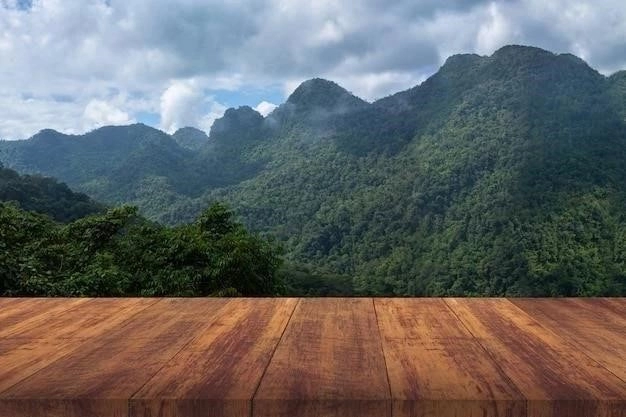Table Mountain, with its iconic flat top, is a globally recognized landmark that dominates the skyline of Cape Town, South Africa․ This natural wonder is not only a scenic spectacle but also a geological treasure trove, holding within its rocky slopes a fascinating story of deep time and powerful earth processes․
Formation over Millennia
The story of Table Mountain begins over 500 million years ago, long before dinosaurs roamed the earth․ Heres a glimpse into the major geological events that shaped this iconic mountain:
-
Sedimentation and the Malmesbury Group (Around 800-540 Million Years Ago)
The very foundations of Table Mountain began as sediments accumulating on the floor of a shallow sea․ These sediments, composed primarily of mud and sand, eventually solidified into a group of rocks known as the Malmesbury Group․ This formation is the oldest in the area and forms the base upon which Table Mountain would later rise․
-
Intrusion of the Cape Granite (Around 630-540 Million Years Ago)
Molten rock, or magma, surged up from deep within the Earths crust, intruding into the existing Malmesbury Group․ This magma cooled and solidified to form the Cape Granite, a hard, resistant rock that now constitutes the core of Table Mountain․ Although largely hidden beneath the surface, the Cape Granite played a crucial role in the mountains uplift․
-
Deposition of the Table Mountain Group (Around 540-340 Million Years Ago)
Over millions of years, a new sequence of sediments, primarily sand and gravel, were deposited on top of the eroded surface of the Malmesbury Group and Cape Granite․ This thick layer of sediments eventually hardened into the rocks that we know today as the Table Mountain Group․ The most prominent member of this group is the incredibly durable Table Mountain Sandstone, responsible for the mountains distinctive flat top and steep cliffs․
-
Folding and Uplift (Around 300-200 Million Years Ago)
The African continent collided with what is now South America, generating immense pressure that caused the Earths crust to buckle and fold․ This tectonic activity resulted in the dramatic uplift of the Cape Fold Belt, a mountain range that extends along the southwestern edge of South Africa․ Table Mountain, composed of the highly resistant Table Mountain Sandstone, was pushed upwards during this period, its flat top a testament to the horizontal layering of the sandstone․
-
Erosion and Shaping (Ongoing)
Once uplifted, Table Mountain was exposed to the relentless forces of erosion․ Wind, rain, and temperature fluctuations gradually sculpted the mountain into its present form․ The harder Table Mountain Sandstone resisted erosion, forming the prominent cliffs and plateau, while the softer underlying rocks eroded more rapidly, creating the slopes and valleys that surround the mountain․

A Closer Look at the Rocks
The geological diversity of Table Mountain is reflected in the variety of rock formations found there․ Here are some of the most notable:
-
Table Mountain Sandstone
This hard, quartzitic sandstone is the most iconic rock of the mountain, forming its prominent flat top and steep cliffs․ It is highly resistant to erosion, which explains the mountains enduring presence․
-
Graafwater Formation
This formation consists of distinctive maroon-colored mudstone and sandstone layers․ It is often found on the lower slopes of Table Mountain and provides a visual contrast to the dominant sandstone․
-
Peninsula Formation
Composed of lighter-grey, pebbly sandstones, this formation makes up a significant portion of Table Mountains mass․
-
Pakhuis Formation
This formation is characterized by the presence of glacially deposited pebbles embedded within the sandstone․ It is found on the upper parts of the mountain and provides evidence of ancient ice ages․

Table Mountain: A Window into the Past
Table Mountain stands as a testament to the immense power of geological forces operating over vast stretches of time․ Its various rock formations, each telling a story of ancient environments and dramatic transformations, offer a unique window into the Earths history; Studying Table Mountains geology allows us to piece together the fascinating puzzle of our planets past, reminding us of the dynamism of the Earth and the intricate processes that have shaped the world around us․
Ecological Significance and Biodiversity
Beyond its geological significance, Table Mountain stands as a biodiversity hotspot, recognized as part of the Cape Floristic Region, a UNESCO World Heritage Site․ This relatively small area is home to an astounding diversity of plant life, with over 9,000 plant species, many of which are found nowhere else on Earth․
The mountains varied topography, ranging from rocky outcrops and cliffs to sheltered valleys and plateaus, creates a mosaic of microclimates and habitats․ This diversity of environments supports a remarkable array of plant communities, including:
- Fynbos: This fire-adapted shrubland is characterized by its tough, evergreen leaves and colorful blooms․ Fynbos is particularly rich in plant species, with many endemic to the Cape region․
- Afromontane Forests: These indigenous forests occur in sheltered ravines and valleys where moisture levels are higher․ They are home to a variety of tree species, ferns, and other moisture-loving plants․
- Peninsula Granite Fynbos: This unique vegetation type thrives on the nutrient-poor soils derived from the underlying Cape Granite; It is known for its high species diversity and the presence of many rare and endangered plants․
The diversity of plant life on Table Mountain supports a rich tapestry of animal life, including mammals, birds, reptiles, amphibians, and invertebrates․ Some notable inhabitants include:
- Table Mountain Ghost Frog: This critically endangered amphibian is found only on Table Mountain and is a testament to the mountains unique and fragile ecosystems․
- Rock Hyrax: These small mammals, also known as “dassies,” are a common sight on the mountains slopes․
- Cape Sugarbird: This striking bird, with its long tail feathers, is a common pollinator of fynbos plants․

Conservation Challenges and Management
Table Mountains ecological integrity faces numerous challenges, primarily from human activities․ These include:
- Invasive Alien Species: Plants and animals introduced from other parts of the world can outcompete native species, disrupting ecosystems and reducing biodiversity․
- Habitat Fragmentation: Urban development and infrastructure projects can fragment habitats, isolating plant and animal populations and making them more vulnerable to extinction․
- Climate Change: Rising temperatures and altered rainfall patterns are likely to have significant impacts on Table Mountains ecosystems, potentially shifting vegetation zones and increasing the frequency and intensity of wildfires․
- Overuse and Tourism Impacts: The mountains popularity as a tourist destination, while economically important, can lead to soil erosion, disturbance of wildlife, and the spread of invasive species․
Managing these threats requires a multi-faceted approach, including:
- Control and Eradication of Invasive Species: Ongoing efforts are focused on controlling and removing invasive plants and animals to protect native biodiversity․
- Habitat Restoration: Restoration projects aim to rehabilitate degraded areas and create corridors to connect fragmented habitats․
- Climate Change Adaptation: Strategies are being developed to help Table Mountains ecosystems adapt to the impacts of climate change․
- Sustainable Tourism Management: Efforts are underway to promote responsible tourism practices that minimize impacts on the environment and maximize benefits for local communities․

A Global Icon and Conservation Priority
Table Mountain, with its iconic flat top, serves as a powerful symbol of Cape Town and South Africa․ Its geological history, spanning hundreds of millions of years, provides a fascinating glimpse into the Earths dynamic past․ Moreover, its incredible biodiversity, with thousands of plant and animal species, many found nowhere else, highlights the ecological significance of this global icon․ Preserving Table Mountains natural heritage for future generations requires a sustained commitment to conservation, research, and responsible management․










